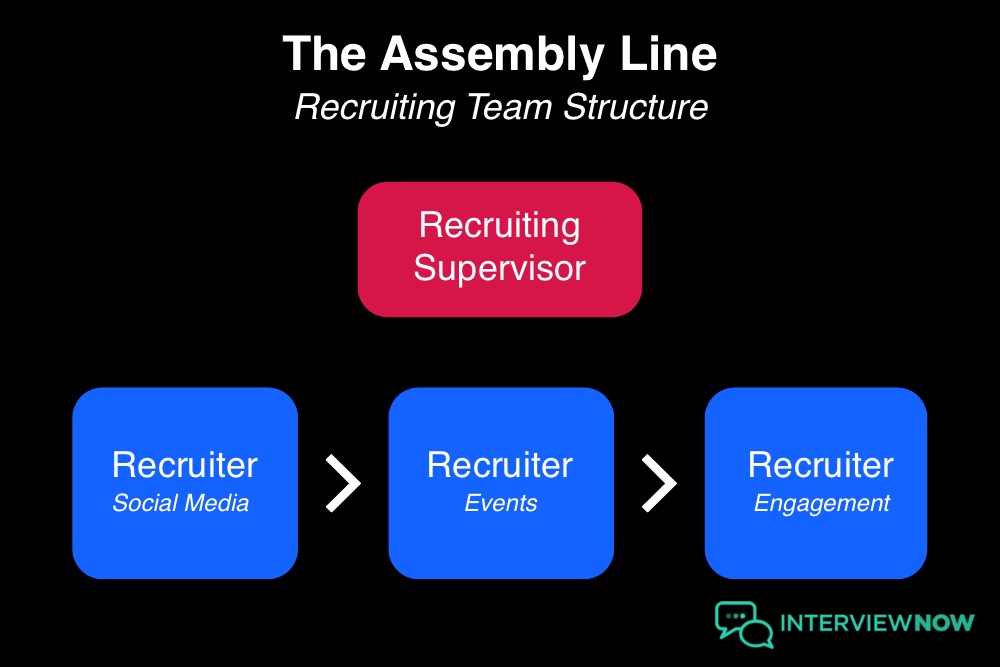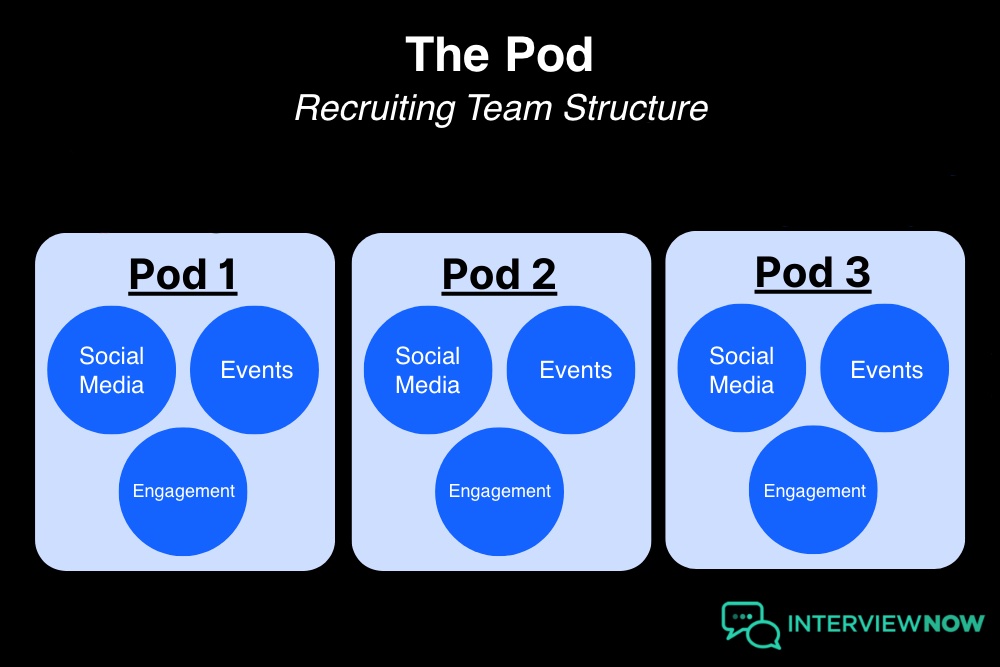
Building the Right Team
This is Recruiting is Sales, a blog exploring law enforcement recruitment as a sales function. This post launches a three part series on building and equipping your sales recruitment team to locate and engage quality candidates and produce results. In our introductory post, we identified recruitment as sales and looked at the failure of the traditional, “post and pray” recruitment process.
Recruiting Unit Organization and Structure
Structure and composition of an effective recruiting unit is absolutely critical to any future success you hope to see. Starting here is essential as you can have everything else “right” but still fail to attract quality candidates if you build on a flawed foundation.

Image used under license from Shutterstock.com
If you trust a farmer with recruiting, you are doomed to repeat past practices and duplicate past failures. New business sales, and recruiting, is a hunter’s game. You need to staff your recruiting unit with go-getters who have a history of high self-initiated activity, an innovative mindset, and well developed social skills. We will look more closely at the “right people” in our next post, Identifying and Selecting Law Enforcement Recruiters, and instead focus on the organizational and structural requirements of an effective recruiting unit.
“Putting the right person in the right position decreases turnover and increases productivity.”
– Stu Schlackman, The Relationship Selling Secret
Too often, recruiting is a secondary responsibility, pushed off on the training unit, a detective, or someone who was simply at the wrong place, at the wrong time, and got “voluntold.” Their performance evaluations focus on their primary role in the organization, they have no clear chain of command for recruitment, and nobody holds them accountable for results. If this sounds familiar, you’ve got a lot of work to do.
Recruitment should seamlessly transition into your background and hiring process, with frequent exchanges of information and close collaboration. As such, personnel involved in recruitment, backgrounds, and hiring should work together, physically located in close enough proximity to facilitate the necessary level of interaction. They should report up the same chain of command and, no higher than the second level supervisor, to someone who is empowered to make many of the administrative and logistical decisions related to recruiting and hiring.
If your agency is not large enough to support one or more full-time recruiters, you need to clearly establish responsibility for recruitment at every level of the org chart. There should be a clear chain of command, established key performance indicators (KPI’s), guidelines on when overtime will be acceptable, as well as an understanding that recruitment will take time away from the recruiter’s primary assignment.
Budgeting for Recruiting
Now that you have identified where in the organization the recruitment team will be placed, you need to give it a budget. Recruiting costs money. Your recruiters will need tools and equipment to help them do their job. Depending on the size of your agency and scale of your recruitment operation, costs may include software solutions, travel expenses, advertising costs, collateral, and swag. I know budgets are tight and there are many competing priorities for each dollar, but the investment you make in your recruitment program will return much more in savings over time.
“Allotted funding of recruitment units and activities is also vital to their success. Administrators should establish a recruitment budget that funds all of the necessary activities and materials for successful recruiting. In addition to providing the actual financial means of recruiting, the establishment of a budget demonstrates the administrator’s ongoing commitment to recruiting and by default the future of the organization.”
– LT Ben Langham, Millennials and Improving Recruitment in Law Enforcement
We will discuss tools and equipment in more detail in the third post of this series, The Right Tools for the Job, but I want to take a minute to discuss swag. Swag, promotional items or handouts which increase brand awareness and help recruiters advance candidates through your recruitment process, is something many organizations (sales and law enforcement alike) get wrong. If you have ever been to a conference with an exhibit hall, you are very familiar with swag. It is all the junk vendors handed you which, more often than not, you threw in the trash a few minutes later.
Do not waste your budget dollars on junky keychains, knicknacks, or toys which are destined for the nearest garbage can. Go with a “less is more” approach and look for quality items candidates will actually keep and appreciate. Quality and customized pens, mugs, t-shirts, and other such items can be incredibly effective at building and spreading your brand.
In 2015, I was in training conducted by the Reno (NV) Police Department and received a custom pint glass with the Reno PD badge on it. Eight years later, it is still one of my favorite glasses and something I use on a regular basis. Find things people will appreciate, keep, and which will continue spreading your brand for years to come, then be more selective about who you give them to.

A Lamborghini Gallardo temporarily loaned to the LAPD for promotional purposes.
Your recruiters need to be mobile and present at community events, local college campuses, area police academies, and anywhere else potential candidates could be found. They will need access to a marked vehicle which presents a professional image of your agency. While not every agency can afford a new Tahoe with a custom recruiting wrap, you cannot send your recruiters out hunting in an old squad put out of service years ago. Consider rotating new vehicles through the recruiting unit as they come in. Wear and tear will be minimal so, when they rotate out of recruiting and into patrol, they will still be like new.
“Too many salespeople operate as mavericks and lone rangers. They attempt to tackle every situation with prospective customers on their own. It could be out of ignorance, pride, or pigheadedness. Whatever the case, it hurts them… Learn to use your resources. Who can help you move a particular opportunity forward?”
– Mike Weinbert, New Sales Simplified
The Recruiting Team
Look for recruiters with diverse backgrounds, who grew up in the communities you recruit out of, and with compelling stories they are willing to share. Find opportunities to tell those stories and regularly feature employees on your social media platforms. We will go into more detail on the benefits of effective storytelling in our fourth series, Elements of Effective Recruiting, but its importance cannot be overstated. A good sales story will win you candidates even when competing agencies are offering higher pay and stronger incentives.
Make the recruiter a desirable role in your organization. Recruiting is critical to the future success of your agency and is worth an investment of time, personnel, and resources to ensure it is done right. If you find ways to make the recruiter role sought after, you will guarantee qualified and motivated candidates will apply and that interest in part-time recruiter positions will remain high. Pick the right people for the team, then give them the authority to be creative and work the problem.
Recruiting Unit Structure
Another key consideration while building your team is structure: how can you optimize recruitment duties and responsibilities to play to your team members’ strengths while covering for weaknesses? In sales, we don’t want just any team, we want a high-performance one. This makes sense, because in sales performance equals revenue. There is a wealth of information available on sales organizational structure and optimization, but this post from the popular Close sales blog does a great job of outlining the three most common team structures in sales as well as their pros and cons.

The Island
The first structure, the one most law enforcement agencies default to, is called “The Island.” In this organizational model, your recruiters are each responsible for every step of the recruitment process with very little collaboration or support. They are islands unto themselves, engaging candidates individually and responsible for overcoming any objections presented by their candidates.
There are advantages to using The Island model, one of which is that it reduces the need for a highly involved supervisor and allows for very simple processes. If each recruiter is responsible for their own “pool” of candidates, the results over time will very clearly show who is performing well and who is not. This reduces the number of moving pieces and the lack of “hand-offs” from one recruiter to another minimizes opportunities for mistakes and miscommunication and generally simplifies the management process. This is a good unit structure if you do not have a strong supervisor to place in command of recruitment, as managing a more complicated process has a higher skill threshold and requires more involvement and experience.
There are, however, disadvantages as well. The Island organizational model isolates each recruiter, making them individually responsible for the full cycle of recruitment, and allows for “drift” in messaging and processes across the team as each recruiter employs their own, individual styles. By isolating recruiters on their own island, we do not allow the strengths of one to supplement the weaknesses of another, lowering the performance ceiling of the unit.

The Assembly Line
The second organizational model Close examines is “The Assembly Line.” This model focuses on maximizing performance by structuring the team to play to its members’ strengths. Isolate different sections of the process, have those sections covered by specialists, and pass candidates from one team member to the next as they advance.
In sales, we generally break roles down into lead generation, qualification, closers, and customer success. We will look at these in more detail, as well as what types of people tend to succeed in each, in our next post Identifying and Selecting Law Enforcement Recruiters. In law enforcement recruitment, you may have some team members specialize in career fairs and community events, others in phone calls and personal engagement, someone focused on social media engagement and campaigns, and a collection of part-timers who come from diverse backgrounds and are available to tell their stories.
However you break down the process, you set your team up for success by always having candidates engaging with the right person for that moment and allowing your recruiters to play to their strengths. Pioneered by Aaron Ross during his time at Salesforce, this approach enables organizations to operate and scale very efficiently while also breaking a complex sales cycle into more manageable components.
While an extremely effective model, The Assembly Line is not without its drawbacks. There are a lot of moving pieces, making it absolutely essential that you have the right tools in place to facilitate the smooth flow of information and to coordinate group efforts. It also narrows each recruiter’s focus, creating silos within the unit which can be detrimental if your supervisor is not actively working to manage them. This requires a strong supervisor who will remain actively involved, understand the process, and be aware of the strengths and weaknesses of each team member.

The Pod
The final organizational model discussed by Close is “The Pod.” The Pod structure is very similar in concept to The Assembly Line, but breaks the overall team down into smaller groups, each responsible for the entire cycle. This model tries to capture the strengths of both previous models but, while it does have some advantages, creates some very real challenges when applied to law enforcement recruiting, including higher personnel requirements. In agencies with a decentralized recruitment process, where multiple teams each recruit for different positions across the agency, this is a viable option. It is important to note, however, that each pod should report up the same chain of command, with one supervisor responsible for overseeing all recruiting efforts for the entire agency.
An effective recruitment program is essential to the long-term success of any agency. Historically, we as a profession have neglected recruiting while focusing almost exclusively on hiring. This was sufficient for most agencies while natural interest in public service and law enforcement was high, but as interest has waned we have struggled to adapt. We can no longer post test dates and links to application portals and call it recruiting. A modern, sales-oriented recruitment program is essential and requires proper placement in the org chart as well as the proper investment of personnel and resources.
What is Next
In our next post we will look closely at what traits and backgrounds you should look for when selecting your recruiting team. We will dive into the “hunter” mentality needed as well as the importance of strong communication skills, emotional intelligence, and cultural competency. Until then, take some time to reevaluate recruitment at your agency and whether you have made the investments necessary for it to truly succeed. Does it have clear placement on your org chart? Does that placement enhance or impede the overall recruiting and hiring process? What does the investment of money and resources your agency has made into the program say about its place on the priority list?
Comments are open and we encourage you to share feedback on this post. Feel free to include programs, resources, and techniques you have tried in your recruiting efforts and the results they delivered. We will monitor comments and do our best to respond in a timely manner.

